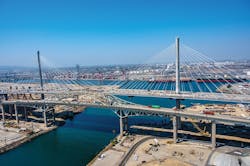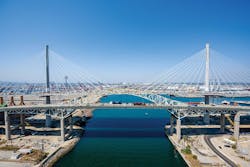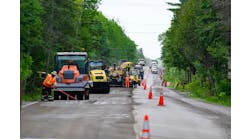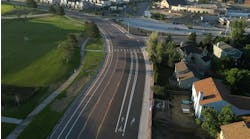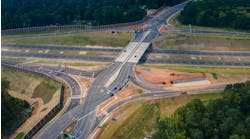The Gerald Desmond replacement bridge is the second-tallest cable-stayed bridge in the U.S. and the first such bridge for vehicles in California.
The six-lane bridge crosses Long Beach’s Back Channel and features a 1,000-ft-long main span between two 515-ft-high towers. The signature cable-stayed span replaces the adjacent arch bridge that connected the Port of Long Beach (POLB) with the mainland for more than half a century. The new bridge will enhance a critical cargo route for one of the busiest U.S. ports.
“The new Gerald Desmond Bridge will have a significant global economic impact, as it provides one of the world’s busiest cargo ports with a reliable connection for freight to begin its journey to the rest of the U.S.,” Doug Ficco, project manager for WSP USA, told Roads & Bridges. “The success of the replacement project was due to constant collaboration among all of the organizations involved from start to finish, and it is a tremendous honor to be listed as one of the top bridge projects this year. It is a testament to the effort taken by so many people who shared a common vision for this bridge.”
The old bridge was too narrow and too low to accommodate today’s roadway cargo traffic demands and the larger cargo ships that began arriving at the Port of Long Beach years ago.
Gerald Desmond Bridge Project Gets Worldwide Attention
Construction of the new bridge has been monitored extensively around the world by engineers and bridge designers since conception and was featured on the Science and Discovery channels, as well as in countless news stories.
The project began in 2013 with a complex operation to clear obstructions from the new bridge’s path, including nearly two dozen active and abandoned oil wells buried deep in the soil. The new bridge required a massive foundation, given there is no bedrock near the surface. Crews drilled and constructed 352 8-ft and 6-ft diameter concrete and rebar piles that were nearly 180 ft deep. The right-of-way work also required realigning large underground utility lines—a process that sometimes required freezing the ground to prevent intrusion from the groundwater table—as well as overhead power lines.
From the foundation rose 100 columns to support approach lanes and the two signature towers. Construction of the approach spans involved the first-ever use of two massive movable scaffolding systems—self-advancing machines that provided workers a safer road construction environment and reduced completion times.
With 80 cable strands holding the center span and column-supported approach lanes featuring more efficient ramps and turning lanes, the new bridge will provide an efficient transition to and from the southern terminus of the 710 Freeway at the east end of this major transportation link, and an integrated connection to SR 47 and Terminal Island at the west end. The project features California’s first-ever “Texas U-turn,” a non-signaled undercrossing that enables continuous travel for motorists.
With the highest deck of any cable-stayed bridge in the U.S., the new bridge is designed to last 100 years with minimal maintenance and is considered one of the most seismically advanced structures in the country. The bridge includes German-designed joints at each end of the main span that move up to 6 ft in three directions during a very strong earthquake. These joints, large dampers, and other features are designed to provide flexibility and elastic points of isolation that enable bridge segments to move independently without causing significant damage to the bridge’s primary superstructure.
The new bridge features 18 million lb of structural steel, 75 million lb of rebar, and 1.7 million ft of cable—all American-made steel. If laid end-to-end, the cables would stretch about 322 miles.
“This is a historic day for our city and for the nation,” Long Beach Mayor Robert Garcia said in a statement at the bridge’s opening ceremony. “We know that this project is a phenomenal marvel of architecture and infrastructure. It connects our port and the world to each other. All of the commerce that we depend on will go over this bridge—connecting Long Beach to the rest of the country.”
The new bridge features emergency lanes on both the inner and outer shoulders in each direction to reduce traffic delays and safety hazards from accidents and vehicle breakdowns, a reduction in the previous bridge’s steep grades to improve traffic flow, and a dedicated bicycle path and pedestrian walkway that features scenic overlooks—eventually bringing visitors to a 205-ft-high view of the Southern California coastline.
The new structure will be named later through state legislation. Once the new bridge is fully operational, plans will be prepared for the demolition of the existing bridge.
